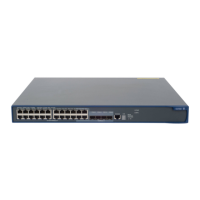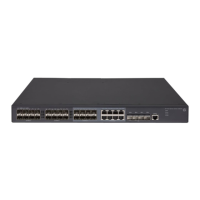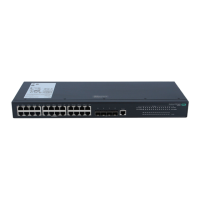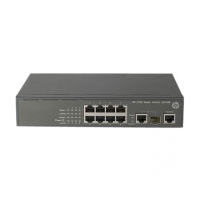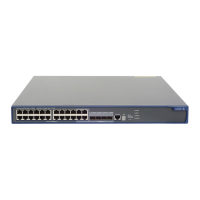106
[RouterA-ospf-1-area-0.0.0.1] nssa
[RouterA-ospf-1-area-0.0.0.1] quit
# Configure Router C.
<RouterC> system-view
[RouterC] ospf
[RouterC-ospf-1] area 1
[RouterC-ospf-1-area-0.0.0.1] nssa
[RouterC-ospf-1-area-0.0.0.1] quit
[RouterC-ospf-1] quit
NOTE:
• To allow Router C in the NSSA area to reach other areas within the AS, you must provide the keyword
default-route-advertise for the nssa command issued on Router A (the ABR) so that Router C can obtain
a default route.
• Configuring the nssa command with the keyword no-summary on Router A can reduce the routing
table size on NSSA routers. On other NSSA routers, you only need to configure the nssa command.
# Display routing information on Router C.
[RouterC] display ospf routing
OSPF Process 1 with Router ID 10.4.1.1
Routing Tables
Routing for Network
Destination Cost Type NextHop AdvRouter Area
10.2.1.0/24 3 Transit 10.2.1.2 10.4.1.1 0.0.0.1
10.3.1.0/24 7 Inter 10.2.1.1 10.2.1.1 0.0.0.1
10.4.1.0/24 3 Stub 10.4.1.1 10.4.1.1 0.0.0.1
10.5.1.0/24 17 Inter 10.2.1.1 10.2.1.1 0.0.0.1
10.1.1.0/24 5 Inter 10.2.1.1 10.2.1.1 0.0.0.1
Total Nets: 5
Intra Area: 2 Inter Area: 3 ASE: 0 NSSA: 0
4. Configure route redistribution:
# Configure OSPF to redistribute the static route on Router C.
[RouterC] ip route-static 3.1.2.1 24 10.4.1.2
[RouterC] ospf
[RouterC-ospf-1] import-route static
[RouterC-ospf-1] quit
# Display routing information on Router D.
<RouterD> display ospf routing
OSPF Process 1 with Router ID 10.5.1.1
Routing Tables
Routing for Network
Destination Cost Type NextHop AdvRouter Area
10.2.1.0/24 22 Inter 10.3.1.1 10.3.1.1 0.0.0.2
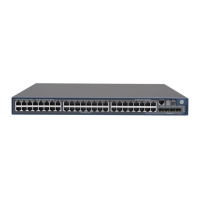
